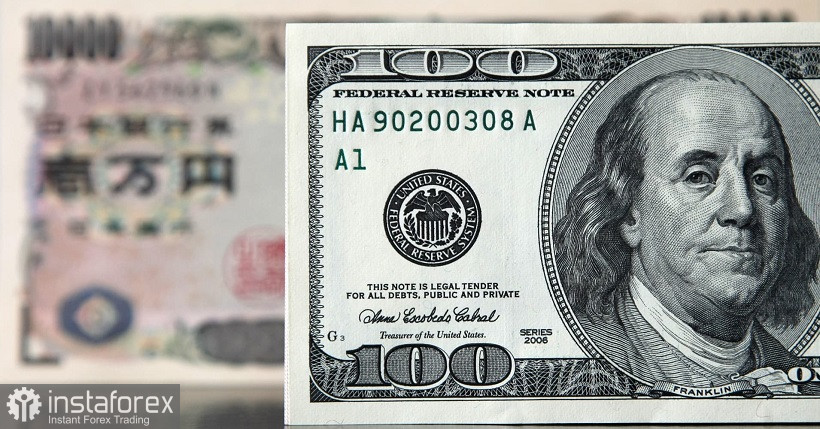One of the main beneficiaries of the panic associated with the emergence of a new strain of coronavirus was the Japanese yen, which, paired with the US currency, strengthened by almost 300 points. The yen, along with the Swiss franc, was in high demand as a protective instrument: the unknown and frightening Omicron allowed the USD/JPY bears to reach a local low of 112.68. However, we should note here the keywords "unknown" and "frightening". Studies of the new modification are continuing, and the situation is gradually becoming clearer every day. And despite the fact that WHO insists that the full picture will be clear only in a few weeks, preliminary reports from individual experts have reduced the degree of heat in the financial markets.
In particular, the National Institute of Infectious Diseases of South Africa stated that most of the people who required hospitalization were not vaccinated against coronavirus. In addition, the head of Pfizer said that the company's specialists are now working on the creation (upgrade) of a vaccine against the Omicron variant. He assured journalists that the new vaccine could be ready in three to four months. He added that Pfizer had already developed and produced updated vaccines in response to Beta and Delta variants, but there was no need for them. In the case of Omicron, it is not known for certain how effectively it "gets away" from antibodies produced by vaccines. It is still unknown whether the drugs already created will cope with the new strain or they will have to be upgraded.
Meanwhile, some experts are building quite optimistic theories, according to which Omicron will be able to organize a kind of "forced vaccination", thereby creating collective immunity for humanity. If the assumptions that a more contagious strain is "harmless" are confirmed, then such a situation will need to be considered in a positive context. Some experts suggest that Omicron will eventually displace the more dangerous Delta, but at the same time provide antibodies to those who, for one reason or another, refuse to be vaccinated.
However, such assumptions have not yet been supported by relevant observations and studies. Let's not forget that there is an alternative, extremely pessimistic scenario in which Omicron will contribute to a more severe course of the disease, "get away" from antibodies, and infect people again faster than Delta. This scenario is also not ruled out yet: the final verdict of the WHO will be issued only in a few weeks.
Nevertheless, the level of anti-risk sentiment in the currency market is gradually decreasing. If panic prevailed among traders at the end of last week, then today, defensive assets are losing their positions. In particular, the USD/JPY pair shows the upward dynamics for the second day in a row. Sellers were unable to consolidate within the 112th figure, after which the initiative was seized by buyers, amid the strengthening of the US currency. The US dollar index has left the local lows and is showing upward dynamics, reflecting increased demand for the US dollar.
It seems that the hype around Omicron overshadowed the central event of the current week and month as a whole. We are talking about tightening the position of Jerome Powell, who announced the early curtailment of QE. Judging by his rhetoric, the stimulus program will be curtailed already in March-April (and not by July, as previously planned). In the spring of next year, the Fed will be able to begin considering raising the rate. And although the head of the Central Bank bypasses the topic of raising the rate, the algorithm of further actions of the regulator is obvious. At least, many experts of the world's largest banks are confident that the Fed will hold several rounds of interest rate increases in 2022.
Such a sharp and rather unexpected reversal by Jerome Powell (who a few weeks ago assured the markets that inflation was temporary) was actually ignored by the market. Omicron did not allow dollar bulls to fully express themselves, in the wake of increased hawkish expectations.
Nevertheless, Powell essentially laid the fundamental foundation for the strengthening of the US currency – both in the medium and long term. This is especially true for the USD/JPY pair since the yen's price has risen only due to the strengthening of anti-risk sentiment. It is advisable to use the current price decline to open longs, especially since the downward momentum for the pair faded the day before yesterday.
The nearest target of the upward movement is the level of 114.00 – this is the average line of the Bollinger Bands, coinciding with the Kijun-sen line on the D1 timeframe. The main target of USD/JPY buyers is the 115.50 target – this is the upper line of the Bollinger Bands on the daily chart. This is the "ceiling" of the range (almost a 5-year price high), so it is not advisable to talk about higher price values yet.
 English
English 
 Русский
Русский Bahasa Indonesia
Bahasa Indonesia Bahasa Malay
Bahasa Malay ไทย
ไทย Español
Español Deutsch
Deutsch Български
Български Français
Français Tiếng Việt
Tiếng Việt 中文
中文 বাংলা
বাংলা हिन्दी
हिन्दी Čeština
Čeština Українська
Українська Română
Română

